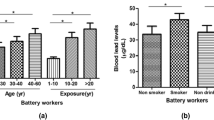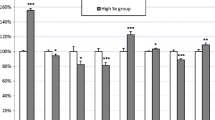Abstract
Previous studies reported that Pb exposure causes a negative association with delta-aminolevulinic acid dehydratase activity (δ-ALAD), but the impact of Pb exposure (dose and time), B vitamin deficiencies, and lifestyle factors needs to be explored. In this study, the impact of Pb exposure, B vitamin deficiencies, and lifestyle factors on δ-ALAD activity among workers exposed to Pb from the Pb-recycling process was evaluated. Blood lead levels (BLLs), B vitamins (B6, B9, and B12), hematological factors (Hb% and HCT), lifestyle factors, and δ-ALAD activity was assessed in 170 male Pb-exposed workers engaged in the Pb recycling process. BLLs are estimated using the ICP-OES method. B vitamins in serum samples from workers were determined using the ELISA method. The δ-ALAD activity in whole blood samples was determined using the spectrophotometer method. The lifestyle factors were collected using a standard questionnaire. The δ-ALAD activity was significantly decreased in workers with the habits of alcohol use, tobacco consumption, hematocrit < 41%, mild and moderate categories of anemia, vitamin B6 and B12 deficiency, and BLL categories of 10–30, 30–50, and > 50 µg/dL. Multiple regression analysis revealed that the independent variables of alcohol consumption (β = − 0.170; P = 0.025), BLLs (β = − 0.589; P = 0.001) and Hb% (β = 0.183; P = 0.001) significantly influenced the δ-ALAD activity with 44.2% (R2 = 0.442). Among the workers exposed to Pb from the Pb recycling plant, δ-ALAD activity was considerably reduced by Pb exposure, B vitamin deficiency, hematological parameters, and lifestyle factors.
Graphical Abstract


Similar content being viewed by others
Data availability
All data generated or analyzed in this study are included in this published article.
References
Foroughi M, Azqhandi MHA (2020) Biological-based adsorbent for a non-biodegradable pollutant: modeling and optimization of Pb (II) remediation using GO-CS-Fe3O4-EDTA nanocomposite. J Mol Liq 318:114077
George A, Venugopal A, Vashisht AK (2023) Heavy metal contamination in soil and ground water around industrial areas of Kollam District, Kerala, India. Environ Monit Assess 95(2):265. https://doi.org/10.1007/s10661-022-10880-5
Bakulski KM, Seo YA, Hickman RC, Brandt D, Vadari HS, Hu H, Park SK (2020) Heavy metals exposure and Alzheimer’s disease and related dementias. J Alzheimers Dis 76(4):1215–1242. https://doi.org/10.3233/JAD-200282
Hettiarachchi GM, Pierzynski GM (2004) Soil lead bioavailability and in situ remediation of lead contaminated soils: a review. Environ Prog 23(1):78–93. https://doi.org/10.1002/ep.10004
Amares S, Tchari B (2020) Effect on shear strength and hardness properties of tin based solder alloy, Sn-50Bi, Sn-50Bi+ 2% TiO2 nanoparticles. Adv Mat Res 1159:54–59. https://doi.org/10.4028/www.scientific.net/AMR.1159.54
Bharatraj DK, Yathapu SR (2018) Nutrition-pollution interaction: an emerging research area. Indian J Med Res 148(6):697. https://doi.org/10.4103/ijmr.IJMR_1733_18
Tan SY, Payne DJ, Hallett JP, Kelsall GH (2019) Developments in electrochemical processes for recycling lead–acid batteries. Curr Opin Electrochem 16:83–89. https://doi.org/10.1016/j.coelec.2019.04.023
Yin J, Lin H, Shi J, Lin Z, Bao J, Wang Y, Lin X, Qin Y, Qiu X, Zhang W (2022) Lead-carbon batteries toward future energy storage: from mechanism and materials to applications. EER 5(3):1–32. https://doi.org/10.1007/s41918-022-00134-w
Markowitz M (2021) Lead poisoning: an update. Pediatr Rev 42(6):302–313. https://doi.org/10.1542/pir.2020-0026
Du X, Zheng W, Ye Q (2020) Rare cases of severe life-threatening lead poisoning due to accident or chronic occupational exposure to lead and manganese: diagnosis, treatment, and prognosis. Toxicol Ind Health 36(12):951–959. https://doi.org/10.1177/0748233720958969
Kim J, Lee Y, Yang M (2014) Environmental exposure to lead (Pb) and variations in its susceptibility. J Environ Sci Health C 32(2):159–185
Nariya A, Pathan A, Shah N, Patel A, Chettiar S, Vyas J, Shaikh I, Jhala D (2017) Association of delta-aminolevulinic acid dehydratase polymorphism with blood lead and hemoglobin level in lead exposed workers. Annu res rev biol 17(5):1–7. https://doi.org/10.9734/ARRB/2017/35844
Schauder A, Avital A, Malik Z (2010) Regulation and gene expression of heme synthesis under heavy metal exposure-review. J Environ Pathol Toxicol Oncol 29(2):137–158. https://doi.org/10.1615/JEnvironPatholToxicolOncol.v29.i2.70
Jaffe EK, Martins J, Li J, Kervinen J, Dunbrack RL (2001) The molecular mechanism of lead inhibition of human porphobilinogen synthase. J Biol Chem 276(2):1531–1537. https://doi.org/10.1074/jbc.M007663200
Unnikrishnan B, Lien CW, Chu HW, Huang CC (2021) A review on metal nanozyme-based sensing of heavy metal ions: challenges and future perspectives. J Hazard Mater 401:123397. https://doi.org/10.1016/j.jhazmat.2020.123397
Ramirez Ortega D, González Esquivel DF, Blanco Ayala T, Pineda B, Gomez Manzo S, Marcial Quino J, Carrillo Mora P, Perez de la Cruz V (2021) Cognitive impairment induced by lead exposure during lifespan: mechanisms of lead neurotoxicity. Toxics 9(2):23. https://doi.org/10.3390/toxics9020023
Kou H, Ya J, Gao X, Zhao H (2020) The effects of chronic lead exposure on the liver of female Japanese quail (Coturnix japonica): histopathological damages, oxidative stress and AMP-activated protein kinase based lipid metabolism disorder. Ecotoxicol Environ Saf 190:110055. https://doi.org/10.1016/j.ecoenv.2019.110055
Xuan Y, Yang Y, Xiang L, Zhang C (2022) The role of oxidative stress in the pathogenesis of vitiligo: a culprit for melanocyte death. Oxid Med Cell Longev 2022:8498472. https://doi.org/10.1155/2022/8498472
Rafiee A, Ospina MB, Pitt TM, Quemerais B (2022) Oxidative stress and DNA damage resulting from welding fumes exposure among professional welders: a systematic review and meta-analysis. Environ Res 2014(pt 4):114152. https://doi.org/10.1016/j.envres.2022.114152
Mehrotra R, Kopple JD (2004) Nutrition and anemia in end stage renal disease. Nutr Manag Renal Dis 369–377
Ge Y, Zadeh M, Mohamadzadeh M (2022) Vitamin B12 regulates the transcriptional, metabolic, and epigenetic programing in human ileal epithelial cells. Nutrients 14(14):2825. https://doi.org/10.3390/nu14142825
Koury MJ, Ponka P (2004) New insights into erythropoiesis: the roles. Annu Rev Nutr 24:105–131. https://doi.org/10.1146/annurev.nutr.24.012003.132306
Buyuksekerci M, Bal C, Alaguney M, Agış E, Gunduzoz M, Hocaoglu A, Tutkun L, Yilmaz O (2015) Evaluation of folate and vitamin B12 levels in lead exposed workers. Dicle Tip Derg 42(3):294–298. https://doi.org/10.5798/diclemedj.0921.2015.03.0577
Sharma NR (2013) Resilience and self-efficacy as correlates of well-being among the elderly persons. J Indian Acad Appl Psychol 39(2):281
De Almeida Lopes AC, Navas-Acien A, Zamoiski R, Silbergeld EK, Carvalho MD, Buzzo ML, Urbano MR, Martins AD, Paoliello MM (2015) Risk factors for lead exposure in adult population in southern Brazil. J Toxicol Environ Health Part A 78(2):92–108
Hasani IW, Mohamed A, Sharaf NE, Shakour AA, Fahim YA, Ibrahim KA, Elhamshary M (2016) Lead and cadmium induce chromosomal aberrations and DNA damage among foundry workers. J Chem Pharm Res 8(2):652–661
Quinto L, Aponte JJ, Menendez C, Sacarlal J, Aide P, Espasa M, Mandomando I, Guinovart C, Macete E, Hirt R, Urassa H (2006) Relationship between haemoglobin and haematocrit in the definition of anemia. Trop Med Int Health 11(8):1295–1302. https://doi.org/10.1111/j.1365-3156.2006.01679.x
Berlin A, Schaller KH (1974) European standardized method for the determination of delta-aminolevulinic acid dehydratase activity in blood. Z klin Chem klin Biochem 12(8):389–990
Schwartz J, Landrigan PJ, Feldman RG, Silbergeld EK, Baker EL Jr, von Lindern IH (1988) Threshold effect in lead-induced peripheral neuropathy. J Pediatr 112(1):12–17
Aggarwal A, Aggarwal A, Goyal S, Aggarwal S (2020) Iron-deficiency anemia among adolescents: a global public health concern. Int J Adv Community Med 3(2):35–40
de Benoist B (2008) Conclusions of a WHO technical consultation on folate and vitamin B12deficiencies. Food Nutr Bull 29:S238–S244
Obol JH (2016) Reduced plasma concentrations of vitamin B6 and increased plasma concentrations of the neurotoxin 3-hydroxykynurenine are associated with nodding syndrome: a case control study in Gulu and Amuru districts, Northern Uganda. Pan Afr Med J 24:123. https://doi.org/10.11604/pamj.2016.24.123.8409
Pala K, Turkkan A, Gucer S, Osman E, Aytekin H (2009) Occupational lead exposure: blood lead levels of apprentices in Bursa. Turkey Ind Health 47(1):97–102. https://doi.org/10.2486/indhealth.47.97
Patharkar SA, Benwal SJ, Nerurkar AV, Patil N (2019) Estimation of urinary delta aminolevulinic acid levels in garage workers as an index of lead exposure. Indian J Clin Biochem 23(3):312–315
Huang C, Liu T, Yang C, Wang C, Lee S, Dai C, Chuang H (2018) The threshold of the delta-aminolevulinic acid dehydratase (δ-ALAD) activities reduced by lead (Pb) exposure could be 10 μg/dL without modification of δ-ALAD G177C genotypes in Chinese Han Taiwanese. https://doi.org/10.20944/preprints201809.0020.v1
Chiu YW, Liu TY, Chuang HY (2013) The effects of lead exposure on the activities of δ-amino-levulinic acid dehydratase with the modification of the relative genotypes. E3S Web Conf.1p26005
Were FH, Moturi MC, Gottesfeld P, Wafula GA, Kamau GN, Shiundu PM (2014) Lead exposure and blood pressure among workers in diverse industrial plants in Kenya. J Occup Environ Hyg 11(11):706–715. https://doi.org/10.1080/15459624.2014.908258
Huang CC, Yang CC, Liu TY, Dai CY, Wang CL, Chuang HY (2020) Use of generalized additive model to detect the threshold of δ-aminolevulinic acid dehydratase activity reduced by lead exposure. Int J Environ Res Public Health 17(16):5712
Sudjaroen Y, Suwannahong K (2017) Biomarker related lead exposure of industrial battery’s workers. Ann Trop Med Public Health 10(1):194–198. https://doi.org/10.4103/1755-6783.196523
Haider MJ, Qureshi N (2013) Studies on battery repair and recycling workers occupationally exposed to lead in Karachi. Rocz Panstw Zakl Hig 64(1):37–42
Shraideh ZA, Badran DH, Hunaiti AA, Battah A (2019) Delta-aminolevulinic acid dehydratase inhibition and RBC abnormalities in relation to blood lead among selected Jordanian workers. Jordan J Biol Sci 12(2):237–241
Acknowledgements
The authors are grateful to the Director in-charge, ICMR-National Institute of Occupational Health, for his support and encouragement in conducting this study. The authors are thankful to Mrs. N. Thara, Mr. Rajeev Yadav, Mr. Panja Kumar and Mr. Prakash Nayak for their technical assistance. Last but not least, the authors are grateful to the study participants, who willingly cooperative with the study.
Funding
This research project is funded by the Indian Council of Medical Research, India (Grant No. 2018-2811).
Author information
Authors and Affiliations
Corresponding author
Ethics declarations
Conflict of interest
The authors declare no conflict of interest.
Additional information
Publisher's Note
Springer Nature remains neutral with regard to jurisdictional claims in published maps and institutional affiliations.
Supplementary Information
Below is the link to the electronic supplementary material.
Rights and permissions
Springer Nature or its licensor (e.g. a society or other partner) holds exclusive rights to this article under a publishing agreement with the author(s) or other rightsholder(s); author self-archiving of the accepted manuscript version of this article is solely governed by the terms of such publishing agreement and applicable law.
About this article
Cite this article
Adepu, V.K., Kumar, H.S.S., Ravibabu, K. et al. Effect of Pb-exposure and B vitamin deficiencies on δ-aminolevulinic acid dehydratase activity among workers from Pb recycling plants. J Biol Inorg Chem (2024). https://doi.org/10.1007/s00775-023-02042-w
Received:
Accepted:
Published:
DOI: https://doi.org/10.1007/s00775-023-02042-w




